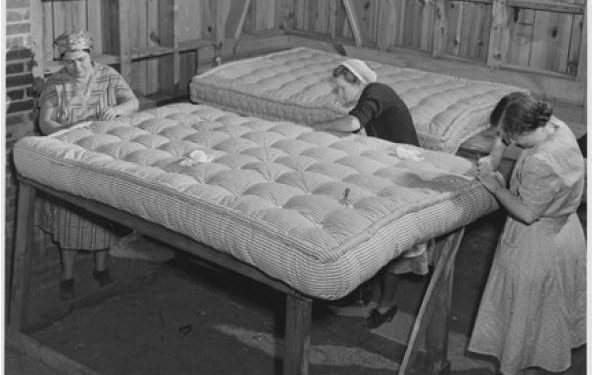Exactly 77,000 years ago, the inhabitants of the Sibudu cave, one of the last colonies of our relatively recent Neanderthals and located on the bank of the Tongati River in South Africa, invented the product we call the bed today, igniting a never-ending development movement. When their possibilities were limited, they used the plant called Cryptocarya existed in the near geography, which has insect repellent properties, as a kind of comfort material by placing it in the shallow holes they opened. In order to acknowledge their rights, I think it is okay to say that the inhabitants of the Sibudu Cave were the inventors of the first bed made with biomaterials in history.
Our invention, which started with a plant we discovered, has been shaped by the contribution of ancient civilizations and reached the middle and near ages and from there to the present. These civilizations who were the first to use natural materials such as wool, cotton, straw, and pea leaves to sleep on. The changing needs and the effect of mechanization with the Industrial Revolution made it possible for us to meet Berliner Heinrich Westphal in the last quarter of the 1800s. Westpal was the first person to give the mattress an industrial identity with the Innerspring (Bonnel) system of spring, which he invented in 1875. The metal wires used in the seats of the horse-drawn carriages would now be put into the bed on which we sleep. Manufactured by wrapping fabric around the spring block, innerspring mattresses were so popular that Westphal remained the market leader until 1920.
Although Westphal’s bonnel spring has serious advantages in terms of rapid production, it was particularly disturbing for the couples due to the movement transfer occured by the interconnected wires. James Marshall, an engineer, thought that this problem would only be possible if the contact between the springs was eliminated. He invented pocket coils, also called pocket springs, in 1899 and prevented motion transfer. This support material, patented in 1900, was placed in the bed one by one at that time.
The 1920s witnessed the efforts to turn rubber tree milk into block material by mixing it with various non-toxic chemicals. After 5 years of trials, rubber milk turned into an ultra-elastic material that we call Latex Sponge. The first latex form produced was to be named after its manufacturer, Dunlop.
Latex sponge used in bed in 1931; In a short time, it became one of the popular materials due to its naturalness, elasticity, breathability and of course its durability. Today; The quality of this type of sponge, which has varieties such as Natural Latex, Synthetic Latex, Blended Latex and SBR Latex, depends on the ratio of rubber milk. The chemical called Styrene Butadiene, which is blended and used in the mixture of SBR (Synthetic) Latex, is also used to make natural latex form a sponge. Approximately 97% of the natural latex sponge produced with today’s technology is rubber milk. Latex beds, which were preferred only by branded hotels for a period, are now offered at relatively accessible prices.
The 1940s witnessed the rapid rise of polyurethane foam as a mattress raw material. Being a petrochemical product made it more economical and faster to produce. Polyurethane foam, which is used as support sponge for springless mattresses, pool sponge and transition sponge in spring mattresses, still continues to be the most preferred form of sponge.
The 1960s were a time when US space studies were intense. The Americans, who made plans to go to the moon, were looking for ways to reduce the pressure on the astronauts during the launch of the shuttle from the ramp. Studies by NASA came to fruition in 1966, resulting in a viscoelastic sponge with pressure absorption properties. The fact that it was gathering very slowly distinguished it from other sponges. When it was seen that the viscoelastic sponge, which was started to be used in hospitals in the 80’s due to its pressure reducing feature, reduced pressure sores on the patients’ body, it started to attract the attention of bedding companies. This sponge, which was used in the mattress sector in the 90’s, did not push the body, contrary to the habits, it restricted the movement by pulling it completely into the bed. Viscoelastic sponge, which is known as Memory Sponge by the industry due to its molecular structure and viscous feature, is an effective material used in reducing pain caused by musculoskeletal problems and preventing dermal pressure. With these qualities, it is used not only in mattress and pillow making, but also in shoe soles.
The five basic materials, the most recent of which have been mentioned with us for half a century, are among the indispensable materials of the mattress industry today. Bonel spring, which has been with us for more than a century, has undergone many changes since its production. There are many varieties that are referred to by different names, but basically do the same job due to their continuous positioning. Pocket springs are not stacked individually as before, springs with different wire thicknesses in the same bed can be used locally and combined by typesetting machines. Latex is still the symbol of naturalness, endurance, cool sleep and more valuable than ever. Memory foam continues to develop and change, especially with the infusion studies of online bedding companies. The bedding industry looks set to continue to change what is existing and develop new inventions, inspired by a story that started 77,000 years ago.





